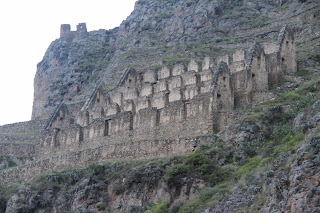 |
| View from the temple complex |
 |
| View from the Pinkylluna on the opposite hill. |


 The unpronounceable Ollantaytambo (thankfully known to locals as Ollanta) was one of my favorite places in Peru.I think I loved it so much because it was just as impressive as Machu Picchu (#1000) but unless you've been there, you probably haven't heard of it. It is the stepping off point for almost all travelers to its more famous cousin as the train and Inca trail both depart from here. I like to think that this was the place that travelers visited when they came before Machu Picchu was discovered (pre-1915). The Sacred Valley has many beautiful sites, but this one is just so charming, and it has been continually inhabited since before the Spanish arrived (13th Century), and you can still see the stone work in the walls of the houses.
The unpronounceable Ollantaytambo (thankfully known to locals as Ollanta) was one of my favorite places in Peru.I think I loved it so much because it was just as impressive as Machu Picchu (#1000) but unless you've been there, you probably haven't heard of it. It is the stepping off point for almost all travelers to its more famous cousin as the train and Inca trail both depart from here. I like to think that this was the place that travelers visited when they came before Machu Picchu was discovered (pre-1915). The Sacred Valley has many beautiful sites, but this one is just so charming, and it has been continually inhabited since before the Spanish arrived (13th Century), and you can still see the stone work in the walls of the houses.

60km northwest of Cuzco at 2792m elevation, it is a backed on three sides by steep mountains. The beautiful Rio Urubamba glides quietly past down the hill from town, but the spectacular part of the location are the two Inca sites that tower over the town. The Incan city planning is evident in the narrow cobble-stoned streets and alleyways, well-designed for the rainy climate with deep drains on either side of every path. The Spanish moved the square away from the original Incan space, to where the original entrance to town was.

The Spanish can't remember the town too fondly as it is one place where they suffered a loss in a major battle. After Manco Inca retreated here after his Sacsaywaman loss, Hernando Pizzaro followed him here in 1536, along with 70 cavalrymen and other indigenous and Spanish foot soldiers. The site makes a magnificent stronghold with its high ground, and it was used well with arrows being showered down on the advancing troops, and prepared irrigation channels allowed Manco Inca to flood the plains below the fortress. Retreating Spaniards were further harassed by the victorious Incas, although they were to return and conquer, of course.



Under the Incas it was the royal estate of Emperor Pachacuti, and the terraced area, mis-labeled as a fortress, protected and provided for an important temple, and beautifully worked stone can still be seen at the top of the terracing (not to mention in the terrace construction itself which were made of cut stone instead of rough rock). The site was unfinished and while some may attribute this to the arrival of Europeans, it was actually more likely to be caused by the war of succession between Huascar and Atahualpa. The rock was mined a considerable 6km away and shows both incredible engineering and transportation skills, especially considering they diverted the whole river around the stones rather than attempt to cross with them! Further signs of their water management can be found up the valley from town in the sites of the
Templo de Agua and the Baño de la Ñusta where small fountains and water pools are intact, although mostly dry. The terraces themselves were incredible as they created mini-climates 2 to 3 degrees warmer than the surrounding area, allowing lower altitude plants to be grown at this height.

 On the other side of town, the Pinkulluna (Inca storehouses) can be seen in 3 clear rows high up on the hillside.
On the other side of town, the Pinkulluna (Inca storehouses) can be seen in 3 clear rows high up on the hillside.
Source: Lonely Planet Peru 7th Edition (2010)



No comments:
Post a Comment